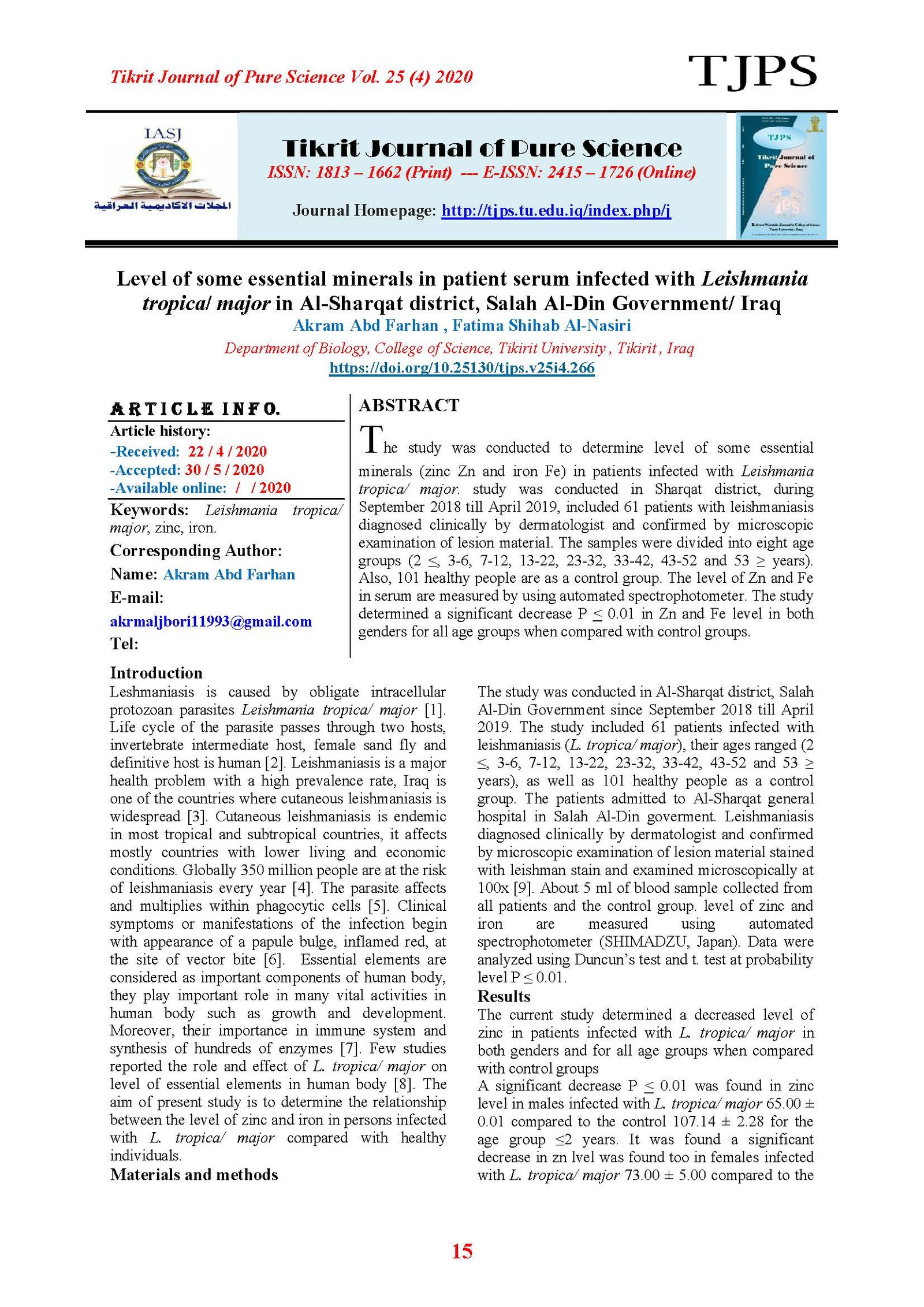Level of some essential minerals in patient serum infected with Leishmania tropica/ major in Al-Sharqat district, Salah Al-Din Government/ Iraq
Main Article Content
Abstract
The study was conducted to determine level of some essential minerals (zinc Zn and iron Fe) in patients infected with Leishmania tropica/ major. study was conducted in Sharqat district, during September 2018 till April 2019, included 61 patients with leishmaniasis diagnosed clinically by dermatologist and confirmed by microscopic examination of lesion material. The samples were divided into eight age groups (2 ≤, 3-6, 7-12, 13-22, 23-32, 33-42, 43-52 and 53 ≥ years). Also, 101 healthy people are as a control group. The level of Zn and Fe in serum are measured by using automated spectrophotometer. The study determined a significant decrease P < 0.01 in Zn and Fe level in both genders for all age groups when compared with control groups.
Article Details

This work is licensed under a Creative Commons Attribution 4.0 International License.
Tikrit Journal of Pure Science is licensed under the Creative Commons Attribution 4.0 International License, which allows users to copy, create extracts, abstracts, and new works from the article, alter and revise the article, and make commercial use of the article (including reuse and/or resale of the article by commercial entities), provided the user gives appropriate credit (with a link to the formal publication through the relevant DOI), provides a link to the license, indicates if changes were made, and the licensor is not represented as endorsing the use made of the work. The authors hold the copyright for their published work on the Tikrit J. Pure Sci. website, while Tikrit J. Pure Sci. is responsible for appreciate citation of their work, which is released under CC-BY-4.0, enabling the unrestricted use, distribution, and reproduction of an article in any medium, provided that the original work is properly cited.
References
[1] Roberts, L. S. and Janovy, J. (2013). Fuondation of Parasitology. 9th (edn.). McGraw-Hill. USA. 88-92 p.
[2] WHO. (1990). Control of leishmaniasis. Technical Report Series, 793: 158p.
[3] Mandell, G. L.; Douglas, R. G. and Bennett, J. E. (1990). Principles and Practice of infectious disease. 3rd (edn.). Churchill Livingstone, New York: 1680 p.
[4] Doroodgar, A.; Arbabi, M.; Razavi, MR.; Mohebali, M. and Sadr, F. (2009). Treatment of cutaneous leishmaniasis in murine model by hydroalcoholic essence of Artemisia sieberi. Iranian Journal of Arthropod-Borne Diseases, 2 (2): 42- 47.
[5] David, M. M. and Miles, S. A. (2007). Avoidance of innate immune mechanisms by the protozoan parasite Leishmania spp. In: Protozoans in macrophages. Eric, D. and Ricardo, G. (eds.). Landes Bioscince, USA: 118- 129 p.
[6] Bessat, M. and El Shanat. S. (2013). Leishmaniasis: Epidemiology, control and future perspectives with special emphasis on Egypt. Journal of Tropical Disease, 3 (1): 1-10.
[7] Al-Fartusie, F. S. and Mohssan, S. N. (2017). Essential Trace Elements and Their Vital Roles in Human Body. Indian Journal of Advances in Chemical Science, 5 (3): 127-136.
[8] Pourfallah, F.; Javadian, S.; Zamani, Z.; Saghiri, R.; Sadeghi, S. and Zarea, B. (2009). Evaluation of serum levels of zinc, copper, iron and zinc/copper ratio in cutaneous leishmaniasis. Journal of Arthropod-Borne Diseases, 3 (2): 7-11.
[9] Sood, R. (1987). Introduction laboratory technology (methods and interpretations), 2nd edn. Japee Brothers, New Delhi: 390 p.
[10] Farzin, L.; Moassesi, M. E. and Sajadi, F. (2014). Alteration of serum antioxidant trace elements (Se, Zn and Cu) status in patients with cutaneous leishmaniasis. Asian Pacific Journal of Tropical Disease, 4 (1): 445-448.
[11] Faryadi, M. and Mohebali, M. (2003). Alteration of serum zinc, copper and iron concentration in patients with acute and chronic Cutaneous Leishmaniasis. Iranian Journal of Public Health, 32 (4): 53-58.
[12] Kocyigit, A., Erel, O.; Gurel, M. S.; Avci, S. and Aktepe, N. (1998). Alteration of serum selenium, zinc, copper and iron concentrations and some related antioxidant activities in patients with Cutaneous Leishmaniasis. Biological Trace Element Research, 65 (3): 271-81.
[13] Mertz, W. (1981). The essential trace elements. Science, 213 (4514): 1332-1338.
[14] Nelson, S. K.; Huang, C. D. and Mathias, M. M. (1992). Copper marginal and copper deficient diets decrease aortic prostacyclin production and copper dependent superoxide dismutase activity and increase aortic lipid peroxidation in rats. Journal of Nutrition, 122 (11): 2101-2108.
[15] Barber, E. F. and Cousins, R. J. (1988). Interleukin-1 stimulated induction of ceruloplasmin synthesis in normal and copper-deficint rats. Journal of Nutrition, 118 (3): 375-381.
[16] Tudor, R.; Zalewski, P. D. and Ratnaike, R. N. (2005). Zinc in health and chronic disease. The Journal of Nutrition, Health and Aging, 9 (1): 45-51.
[17] Bonaventura, P.; Benedetti, G.; Albarede, F. and Miossec, P. (2015). Zinc and its role in immunity and inflammation. Autoimmunity Reviews, 14 (4): 277-285.
[18] Haase, H. and Rink, L. (2013). Zinc signals and immune function. Biofactors. 40 (1): 27-40.
[19] Rofe, A. M.; Philcox, J. C.; Coyle, P. (1996). Trace metal, acute phase and metabolic response to endotoxin in metallothionein in-null mice. Biochemical Journal, 314 (3): 793-797.
[20] Mahdi, N.K.; Sadoon, I. A. and Mohamed, A. T. (1996). First report of cryptosporidiosis among Iraqi children. Eastern Medit. Health Journal, 2 (1): 115-120.
[21] Barollo, M.; D’Incà, R.; Scarpa, M.; Medici, V.; Cardin, R.; Bortolami, M.; Ruffolo, C.; Angriman, I.; Sturniolo, G. C. (2005). Effects of iron manipulation on trace elements level in a model of colitis in rats. World of Journal Gastroenterology, 11 (28): 4396-4399.
[22] Peralta, V.; Cuesta, M. J. and Mata, I. (1999). Serum iron in catatonic and noncatatonic psychotic patient. Biological Psychiatry, 45 (6): 788-90.
[23] Lin, M.; Rippe, R. A.; Niemela, O.; Brittenham, G. and Tsukamoto, H. (1997). Role of iron in NF-kappa B activation and cytokine gene expression by rat hepatic macrophages. American Journal of Physiology, 272 (6): 1355-1338.
